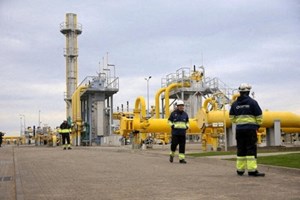Europe’s gas prices slide on swollen inventories
(Reuters) - Europe has made a relatively slow start to rebuilding gas inventories but stocks were so high at the end of last winter that storage sites are still on course to be full well before summer ends, putting downward pressure on prices.

Stocks in the European Union and the United Kingdom increased by +73 terawatt-hours between March 31 and May 9, according to data compiled by Gas Infrastructure Europe (“Aggregated gas storage inventory”, May 11).
The rate of accumulation was far below the +119 TWh added last year, when the region was racing to fill storage following Russia’s invasion of Ukraine, and below the prior 10-year seasonal average of +81 TWh.
But the record carry over from winter 2022/23 ensured stocks had reached 707 TWh on May 9, the second-highest on record for the time of year and +274 TWh (+63% or +1.99 standard deviations) above the 10-year average.
Based on seasonal movements over the last decade, inventories are projected to hit 1,239 TWh before the refill season ends, with a likely range from 1,046 TWh to 1,367 TWh.
The central projection has not changed much since the refill season started on April 1, despite the slower than average accumulation of stocks.
But total storage capacity is estimated at around 1,138 TWh, which means most refill trajectories are physically impossible.
Storage sites were 55.7% full at the end of the winter season on March 31, a record for the time of year, and that had already risen to 62.7% by May 9, still the second-highest on record.
Inventories will have to accumulate much more slowly than average throughout the rest of the summer to ensure space does not run out before winter arrives.
Front-month futures prices have already halved to below 35 euros ($38.53) per megawatt-hour from 77 euros at the start of the year to encourage more consumption, divert LNG cargoes to Asia and slow the stock build.
Prices for deliveries in July 2023 are trading 23 euros below January 2024, with the discount widening from just 4 euros at the start of the year, to stimulate use by energy-intensive industries this summer.
Given the limits on storage capacity, supplies could still be tight in December 2023 and January 2024 if temperatures are colder-than-normal requiring high prices to restrain use.
For now, though, prices are falling as the market tries to cope with too much gas and insufficient demand.
Related News
Related News

- ExxonMobil halts 1-Bft3d blue hydrogen project in Texas
- Aramco and Yokogawa commission multiple autonomous control AI agents at Fadhili gas plant
- Ukraine will resume gas imports via Transbalkan route in November
- Mitsubishi to inject $260 MM into Brunei LNG project
- Freeport LNG (U.S.) on track to take in more natgas on Thursday after unit outage



Comments